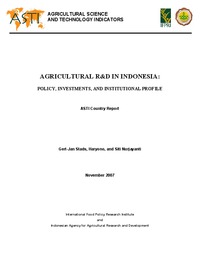Authors:
Stads, Gert-Jan; Haryono; Nurjayanti, Siti
Year:
2007
Publisher
International Food Policy Research Institute (IFPRI); and Indonesian Agency for Agricultural Research and Development (IAARD)
Back to:
Indonesia’s total number of agricultural researchers in Indonesia fell slightly during 1994–2003 due to major reorganizations in government-led agricultural R&D. Nevertheless, with close to 5,000 fte researchers in 2003, Indonesia has one of the largest agricultural research systems in Asia. Despite the decline in researcher totals, qualifications of Indonesian agricultural research staff improved steadily in recent years, principally due to donor-financed training programs. Due to the Asian financial crisis, agricultural R&D spending has been severely cut since 1997. In 2003, the country invested $254 million in agricultural R&D (in 2000 international dollars), which was well below pre-crisis levels.
Like most developing countries around the world, agricultural research in Indonesia is largely a government affair, with the private sector accounting for an estimated 19 percent of total expenditures. IAARD is Indonesia’s central public agricultural R&D agency and it oversees nine major research centers, which focus on socio-economics, soils and agro-climates, engineering, food crops, estate crops, horticulture, livestock, biotechnology, and postharvest activities. IRIEC is a semi-public
R&D agency that is linked to IAARD, but not formally part of it. The institute conducts research on Indonesia’s principal plantation crops (rubber, oil palm, tea, cocoa, coffee, and sugarcane) and is single-handedly by far the largest agricultural R&D agency in the country in terms of research expenditures. FORDA, on the other hand, is the archipelago’s principal agency involved in forestry research. The higher education sector (dominated by IPB) plays a fairly important role in Indonesia as well, accounting for 30 percent of the country’s public agricultural R&D expenditures.
The World Bank-financed ARMP–II has had a serious impact on the structure of Indonesia’s agricultural R&D in the mid-1990s. Rather than a centralized (mostly Bogorbased) agricultural R&D system, research became more decentralized and locationspecific technologies based on farmers’ needs and circumstances were created.
Public agricultural R&D in Indonesia remains largely underfunded by regional and international standards. In 2003, Indonesia invested $0.22 for every $100 of agricultural output, which was nearly 30 percent lower than the equivalent ratio recorded a decade earlier, and half the Asian average of $0.41. In 2003, the national government provided 90 percent of funding to the nine IAARD agencies. Research on plantation crops, on the other hand, is almost entirely financed by the plantation sector itself. IRIEC generates three-quarters of its income internally through the sale of plantation crops and contract research. Close to half of FORDA’s funds come from a reforestation fund, which is allocated proportionally for each hectare of forest logged in the country. Interestingly, IPB-based research is largely financed by the private sector. Although donor funding plays only a limited role in total financial support to Indonesia’s agricultural R&D (compared to some other countries in Southeast Asia), multilateral donor-financed projects such as ARMP–II and PAATP have had a significant impact on the structure and quality of Indonesia’s agricultural R&D system.

